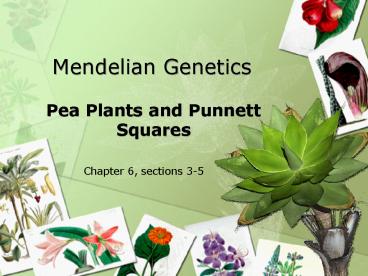Mendelian Genetics - PowerPoint PPT Presentation
1 / 24
Title: Mendelian Genetics
1
Mendelian Genetics
- Pea Plants and Punnett Squares
Chapter 6, sections 3-5
2
Gregor Mendel Father of Genetics
- Austrian monk in mid-1800s
- Interested in nature
- Studied inheritance of traits in pea plants
- Conducted experiments and recorded data
- Developed some basic laws of inheritance
3
Pea Plants because
- fast-growing
- mature quickly
- easy to care for
- have many easy-to-distinguish traits /
characteristics examples flower color
either purple or white, plant height either
tall or short, seed color either green or yellow
4
(No Transcript)
5
Mendels Experiments
Video clip 430
- Step One Mendel allowed plants to
self-pollinate for several generations to make
sure that they were pure, or true-breeding, for
flower color. - Today, we would describe each of these pure
plants as homozygous.
6
Self-Pollination
7
Experiments, contd
- Step Two Mendel took two pure flowers one
purple and one white and cross-pollinated them.
He called these two flowers the P generation (P
for parental). - Results all offspring were purple he called
these offspring the F1 generation (F1 for first
filial)
8
Cross-Pollination
9
Experiments, contd
- Step Three Mendel allowed the F1 flowers
which were all purple - to self-pollinate. The
new offspring were called the F2 generation
(second filial). - Results Roughly 3 out of every 4 flowers was
purple and 1 out of every 4 was white.
10
(No Transcript)
11
Interpreting the Results
- Today, we know that
- purple flower color is dominant to white (in pea
plants) - the white flower color did not completely
disappear it was simply hidden (masked) in the
F1 generation
12
Results, contd
- Remember
- Dominant the allele that always shows up in the
phenotype as long as at least one copy is present - Recessive the allele that will only show up in
the phenotype if there are no dominant alleles
13
Results, contd
- In the F1 generation, all of the plants were
heterozygous (genotype) for flower color they
each had one purple allele and one white allele,
but they all had a purple phenotype (appearance)
14
Results, contd
- In the F2 generation
- one of the purple flowers was homozygous
dominant - the other two purple flowers were heterozygous
- the white flower was homozygous recessive
15
(No Transcript)
16
Punnett Squares
- Now, we can use Punnett squares to show what
happened in Mendels initial experiments
The Punnett Square at left shows the cross
between two pure plants one parent is homozygous
dominant and the other parent is homozygous
recessive. This is like Mendels P generation.
17
Setting up Punnett Squares
18
Punnett Square F1 cross
- For Mendels F1 cross, he allowed plants to
self-pollinate. - The results are shown at right ?
- 75 (3/4) were tall and 25 (1/4) were short.
19
Mendels Conclusions
- Inheritance is based on genes, which are passed
on from parents to offspring. - Some versions of a gene may be dominant while
others may be recessive. - In most sexually reproducing organisms, each
individual has two alleles for each gene one
from each parent.
20
Conclusions, contd
- When gametes (eggs and sperm) form, the two
alleles for each gene separate (segregate) from
each other (Law of Segregation). - When gametes form, different genes separate
(segregate) independently of each other (Law of
Independent Assortment).
21
Law of Segregation
22
Law of Independent Assortment
23
Factors in Mendels Success
- Mendel concentrated on one trait at a time.
- Only after he established the behavior of one
trait (monohybrid cross) did he consider two
traits together (dihybrid cross). - He conducted a large number of crosses
(2000-3000) to eliminate chance and to obtain a
valid and accurate explanation
24
Success, contd
- He actually counted the number of offspring of
each category and maintained accurate records for
each generation in each experiment. - Luck -- though Mendel did not know this -- in the
selection of pea plants as well as in the
selection of the particular traits he studied. - In each pair, one form of the trait is completely
dominant over the other. - It also helped that the genes for the traits
Mendel studied are present on seven different
chromosomes in the pea plant.































